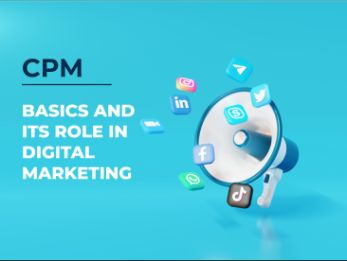CPM: Basics and its role in Digital Marketing
6 mins | 09 Mar 2023

Introduction
Are you interested in understanding the financial side of advertising? If so, you may have heard of CPM - an important metric used to measure the cost-effectiveness of online advertising campaigns.
CPM, or "Cost Per Mille," refers to the cost of reaching one thousand people with an ad. As online advertising continues to grow, CPM has become a crucial tool for advertisers looking to optimize their campaigns and maximize their return on investment.
In this article, we'll dive deeper into CPM, its calculation, and why it matters for businesses and marketers alike. So whether you're a seasoned ad pro or just starting, prepare to learn everything you need about CPM!
What is CPM?
Cost per mile, aka CPM, is a very traditional online marketing metric in which companies pay for views of their advertisement. It's primarily used in advertising media selection, marketing as related to web traffic, and online advertising. One great example that many companies might be familiar with is Google Ads. This platform works on a CPM and a CPC basis.
For instance, if a CPM price is set at INR 500, the advertiser needs to pay INR 500 for every thousand impressions of their ad. Woah, how is this calculated? For that, we need to look at the formula for calculating CPM.
How to calculate CPM?
Calculating CPM is very easy. You can use an online CPM calculator to figure it out or grab a regular calculator. Since CPM is measured per thousand, the CPM formula to calculate it is simple.
CPM = (Ad Spend / Ad Impressions) * 1000
Is there a difference between CPM, CPC, and CPA?
A digital marketing ad campaign is set on a CPM or CPC basis. We have a fair understanding of what a CPM means. Now, what does this CPC stand for? Cost per click (CPC) is the statistic used to show you how well your advertising is doing on search engines, and it is the measurement that marketers most frequently track in any sponsored search campaign.
A CPC marketing campaign is beneficial if you want to pay only when any user clicks on your website and not when he sees your ad. So, if your average CPC is INR 100 and you had 100 clicks, your total expenditure would be INR 1000.
There’s another term called CPA. What does CPA stand for? Cost per action (CPA) is the advertiser's favorite pricing model and probably the least favorite for publishers. CPA is also the most effective and advanced way to generate user actions.
The formula to calculate CPA is:
CPA = campaign cost/conversions
Due to its high value, CPA is the most expensive ad pricing model.
Also Read, Top 4 Social Media Marketing Strategies Of Brand
What are the advantages of a CPM campaign?
There are a plethora of advantages, but if you ask me, it all bottles down to the main advantages of CPM. Here are a few advantages of CPM:
- CPM advertising allows newly formed businesses to increase their visibility on online platforms and expand their brand values.
- CPM can be a beneficial form of advertising to identify the target audience.
- CPM can effectively drive audience conversion with high performance if paired with the right advertising platform.
- CPM gives you a way to plan your marketing investments strategically.
- CPM allows you to test your marketing strategies and analyze the data to optimize overall performance.
What are the disadvantages of a CPM campaign?
Though a CPM campaign can get you a lot of audiences, it has a few cons. The disadvantages of a CPM campaign include low revenue, only working for high-traffic websites, incorrectly counting impressions due to duplicate views, ads that fail to load, and advertising fraud.
How Does a CPM Campaign Work?
By now, you must have the formula to calculate a CPM Campaign by heart, right? But we’ll have a look at the formula once again. So, the formula to calculate a CPM campaign is as follows:
CPM = (Ad Spend / Ad Impressions) * 1000
Let’s put this formula into reality. A website charges the advertiser a specific price for every 1,000 ad views. For example, if a site charges INR 100 CPM, the advertisers pay INR 100 for every 1,000 times their ad appears on a website page.
CPM campaigns are often used for brand awareness, as the goal is to get as many people as possible to see the ad rather than encouraging them to take a specific action. Let’s have a look at how a CPM campaign works:
- A publisher (e.g., a website or mobile app) agrees to host ads from an advertiser.
- The advertiser creates a display ad (e.g., a banner or video ad) and submits it to an ad network or publisher.
- The publisher displays the ad on their website or app, and the ad is counted as an impression each time it is viewed by a user.
- The advertiser pays the publisher a predetermined amount for every 1,000 impressions the ad receives, regardless of whether or not users click on the ad.
- The campaign can be optimized for maximum exposure, targeting specific demographics, devices, locations, or keywords to ensure the most relevant audience sees the ad.
Read Also, What is Email Phishing
Is there an alternative to CPM?
CPM is the average cost per 1,000 impressions of an ad (the “M” stands for a mile, which is the Latin word for 1,000).
The problem with CPM marketing is those impressions tell you only that your ad was displayed, not whether your audience saw or responded to it.
CPM is not a cost-effective option. So, it will be better if we use the alternatives that are available for CPM.
Cost per link click
Cost per link click (CPC) is the average price you pay whenever someone clicks a link in your ad. CPC is the best metric for marketers who drive traffic from search and social to their websites.
Clicks are valuable actions that are worth tracking. When someone clicks a link in your ad, you can do the following:
Pixel them for future retargeting
Use them to build effective look-a-like audiences.
Improve your Ads Quality Score, making it easier to win bids.
Cost per engagement
Cost per engagement (CPE) is the average price you’ll pay each time someone takes action on your ad.
An engagement can be clicking a link or sharing, commenting, or liking an ad. CPE is a great metric for marketers running a branding/awareness/educational campaign.
Engagements prove that your ads are effective at generating awareness. A like, comment or share will account for engagement. This will be proof that the user has actually interacted with the ad post.
Conclusion
While a CPM ad campaign can surely boost your brand’s reach, it doesn’t necessarily mean it will increase your business’ reach and organic website traffic. A CPC ad campaign will work wonders in today’s times.
Do you have any questions or queries related to a CPM ad campaign? Drop them at sales@12grids.com, and we’ll get back to you quickly.
Author







